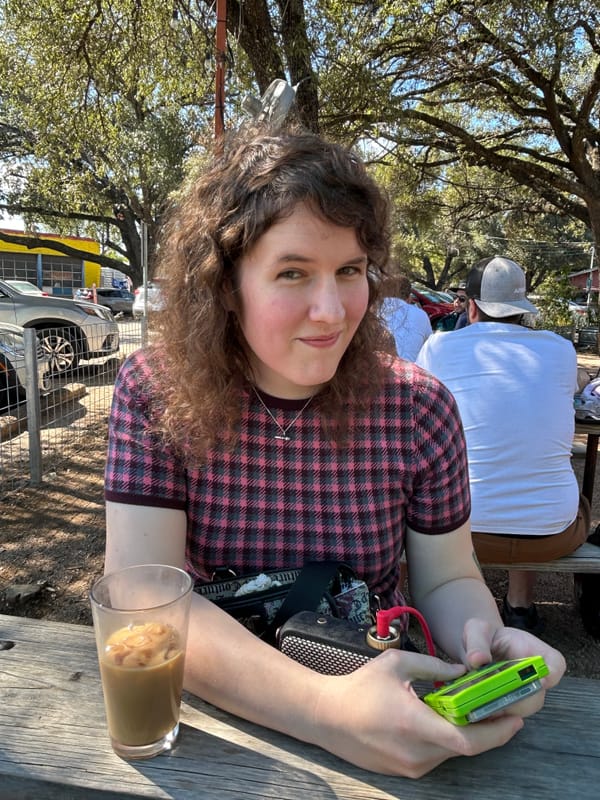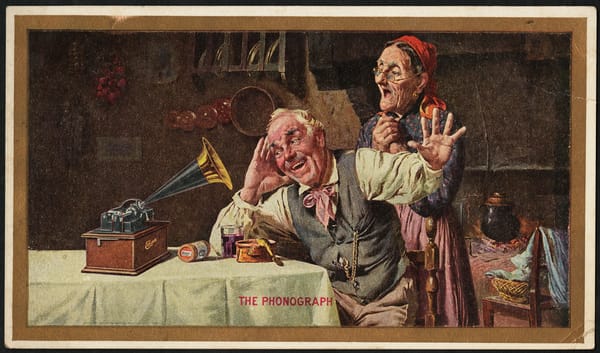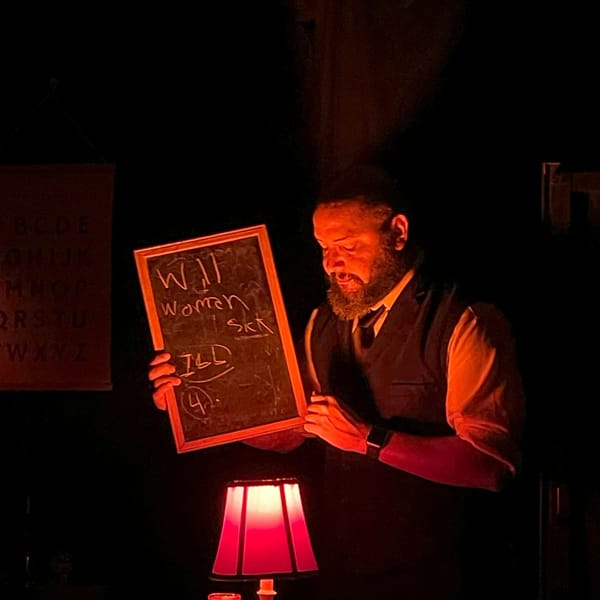Tempered Joy at the Austin History Center
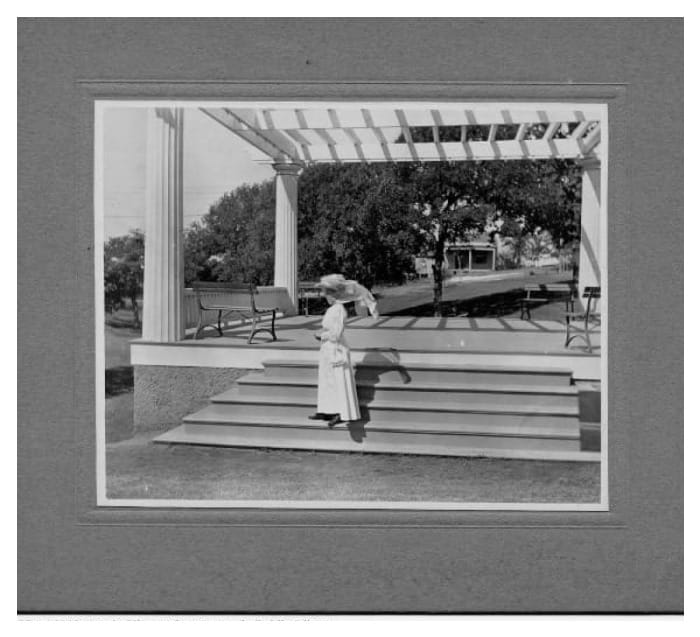
Three cheers for the not-so-distant past of tactile media, when newspapers explained the everyday, books contextualized the past, and DVDs and VHS cassettes made these discoveries audible and extra-visual. The constant flow of commentary describing the present itself becomes history, ready for excavation, especially online. And as for accessing that history, it’s a net social good that historians, librarians and archivists maintain a public database where every citizen can walk in off the street or e-research to use their available resources to explore the past. The Austin History Center (AHC) has all of this — maps, photos, digital files and more that would take a very long time to go through (boxes and boxes of material related to the Whitman murders, and an instructional LP to help you “disco Texas-style” that I’ll get to later).
I wrote my senior project in my biography class on Neal Cassady (taught by the incredible Laura Furman) at the University of Texas, so I was somewhat familiar with the archival process of a place like the Harry Ransom Center. It was an incredible feeling to actively interact with Cassady’s letters in person, being all too aware that one bloody sneeze could have disastrous consequences for myself in the moment and for future researchers. Having been out of the archives for a long time, and knowing that a lot of what I wanted to write about on this website is related to Austin as a part of history (and as an idea), I figured it was time to jump back in.
My decision comes at an unfortunate time, for you. Meaning, if anything I’m writing about here grabs your interest, you’ll have to wait to see it yourself (at least in person). The AHC is currently closed and in the process of spreading itself across two campuses, moving southward to expand into the brutalist cosmic doorstop formerly known as the Faulk Central Library. “Austin Public Library is now developing an integrated campus that will unite its two former main libraries—the Austin History Center and the John Henry Faulk Building—to create expanded archives alongside new areas for programs, exhibits, and events,” reports the AHC’s website. The “big move” is happening in early March, and the new, double AHC will reopen in two months. “The reopening date in the Faulk building at 800 Guadalupe is tentatively scheduled for Wednesday, April 9th,” they say. “The big move is very exciting!”
I’d like to share a little about what I saw and heard on a recent Sunday afternoon and half of a Friday (I took a day off work to do this) at the AHC. I was one of just a few visitors; several members of the AHC staff assisted me with finding material. My list was so long that I wasn’t able to get to everything, but my smattering of left-field requests did result in some interesting finds. I appreciate the workers at the AHC in helping me troubleshoot errant DVD players, gathering odd materials, and otherwise being excellent sports in my scattershot, historical treasure hunt.
CD Roms
A 1999 disc called “Austin and Vicinity,” with the subheading “The World of Nature” boasts of “Over 1000 digital photographs with descriptive notes of wildflowers, other native plants and animals, natural greenbelts, landscapes, vistas, and other natural scenery.” I encountered Wolf spiders, greed red oak gall, epiphytes, Spanish moss, and other things. Of all the times at the AHC when I realized other people were at brunch, watching a game or doing anything other than, say, scrolling through 25+ photos of arachnids, it was during this experience — it’s important that every researcher, on a hunt for important documents or pics of plants, occasionally has pangs of ‘what-am-I-actually-doing-here’ which are then overcome with determination.
Created in 2001, “Austin - a City Within a Park” is a thirteen minute short film made by our Parks and Recreation department demonstrating that they were more than ready to confront the challenges of reaching residents in the new millennium. These include such initiatives as “The Neighborhood Teen Program” described mysteriously as: “It’s sort of like a club for people who want to do something positive with their life.” Other offerings include the “hi tech-reation program,” where kids learn how to utilize the computer to, apparently, place themselves into photos of the Wu-Tang Clan.

I’m guessing this is the “Recreation” part of Parks and Recreation, and I also jotted notes down about the “Totally Cool Totally Art” program mentioned in this video, which still exists.
Manuscripts or Typescripts
Gladys McCarty Shearer came of age in 1920s Austin, and she collected her memories of that time in a kind of sociological autobiography of 33 pages she calls “then add cream - - - OR, THE 1920’s in retrospect” (curious use of caps lock is all her). The typewritten manuscript was published in the late eighties, after Shearer had sixty-odd years to ruminate on the Jazz Age. Her sketch includes remembrances on fashion, dating, and more, all based primarily in Austin. The title “then add cream” reconfigures Proust’s madeleines into milk products:
“For some reason those 3 innocuous little words ‘then add cream’ in a recipe found in a book used by me in a Domestic Science course (forerunner of Home Economics) about 1924 or so - started me to thinking how different things were then…Primarily got interested in the ‘cream’ and started to jot down some notes about it. But when one starts remembering, a flood of memories takes you down all sorts of other paths…This is not only a matter of old ‘school girl’ memories but of evaluating the lifestyle of 60 years ago with that of today and to measure the ‘progress’ however that word not entirely appropriate in a few instances. This much more [sic?] interesting than watching soap operas and knitting!”
On clothes: “Never heard of any formally imposed dress code during these high school or university years but there seemed to be a general concensus [sic] that clothes be decent, clean, modest and sensible.” Those who bucked conformity were fated to be read about one hundred years later: “Remember one time there was a fad to wear gingham bloomers to match the dress (discreetly not seen, of course) and one day a girl who tried to be very sophisticated ran to get ahead of others lined up on steps and fell head over heels rolling down the steps and made quite a scene.”
The author herself was not immune to trends, and suffered an indignation similar to the rolling-down-girl. Of “hobble skirts,” the author says, “I had to have one, of course, and was unfortunate in picking out my first day to wear it on a day we had a light snow. Had to walk some 3 blocks up Blanco hill and on this day when I got a half step forward, slipped back a whole step. Spent what seems hours on that hill as was too modest to take the skirt off and proceed in my petticoat. Needless to say, the skirt got cut off.”
If you think Shearer was a bit naive, meet an elder relation. “I had a great aunt who, with her husband visited Galveston [“around” is in type, and is scratched out with “before” written above it in handwriting] 1900 and, to her amazement, found men and women swimming at the same place in the Bay! This was a ‘sin’ even though women had long bloomer type pantaloons to their ankles, sleeves to wrists, high neck line and wore shoes and a hat. She never recovered. She would also not let a neighbor girl into her house around 1924 because she had on slacks and was therefore a hussy.”
For fun in Austin, Shearer recalls: “Wooldridge Park was also important at that time as many band concerts and other functions held there. Also, as no radio or TV, it was the platform for many a political speech.” (Brief aside, it was interesting to read this with Wooldridge Park a short CD ROM-fling away. The header image of this piece is a photo of the park.) “Entire families would attend these various programs with the younger kids sliding down the grassy slopes on piece of cardboard while the teen agers walked around the park, etc…However, one of our main recreational attractions which today in Austin seems the height of incongruity - - was going down town at night (particularly on Thursday and Saturday nights) and parking on Congress Avenue. We would go shopping, window shopping and primarily to watch window shoppers. The Avenue was definitely downtown with all the stores and shops on it. Most stores left their window lights on at night until at least 9 pm and this was a main attraction.” She concludes that “Today, walking by a bunch of hi rise buildings, stores with for lease or rent signs, would hardly come under the heading of recreation or entertainment.”
She recalls an ad for Deep Eddy pool in a publication called The Comet - “Deep Eddy Bathing beach - there’s Vim in a Swim…featuring swimming, boating, fishing, dancing and with free movies every night.” Of prohibition and speakeasies, Shearer recollects almost enjoying alcohol: “With my background and with my Dad a staunch Prohibitionist (feeling this could cure the ‘evil of drinking’) I was not exposed to any of these. One night, however, when about 18 or so, 2 couples of us were riding around when someone suggested we go to Bill’s Place to sit around and drink gin. Car lightswere [sic] flashed on and off with a response of a window shade rapidly going up and down - sign police were watching. The idea of being arrested in that type of joint made me honest-to goodness sick I had to come home.”
Readers who find this anticlimactic will have no need to steel themselves for the subsection “SEX - AS AFTER ALL NO ARTICLE COMPLETE WITHOUT THIS.” Shearer writes that “Some call it the age of innocence but the age of ignorance would be more appropriate…Probably this was a time of naiveness, unsophistication or just plain dumbness for most and I was one of the dumbest - but so were the most of the rest as all with whom I discussed this concurred with the lack of information.”
What little instruction she received seemed to be that “boys” could cause defiling just by touch, and Shearer remembers that “The greatest fear is the fear of the unknown and I almost went into hysterics for a long time when a boy even brushed up against me in a hallway at school - for fear something horrible might happen. Compare that with today.” As a senior in high school, a sex education lecture was finally made available to an auditorium for just the girls, presented by “two ladies” who “adroitly sidestepped anything and everything. They practically gave the birds and bees version as doubtless they would be highly censored.” Still, Shearer recalls one girl fainted.
The reasons I’ve shared so much of Shearer’s memoir is that the time and place is so particularly familiar and strange, and written in such a natural way. She also keeps her nostalgia in check with an understanding of some of the downsides of such a limited upbringing - I’m sure she wouldn’t begrudge the young women of today for not having a fear of the accidental male touch or the freedom to discard confining skirts. Plus, the future is bright, and warm. She writes, with joy: “Now they are talking about putting microwaves in cars!”
Microfilm
Fun with cream aside, the most interesting finds during my time at the Austin History Center were uncovered sliding through microfilm of the many shuttered newspapers that operated in Austin. Austin Facts was a pro-prohibition paper dotted with advertisements for “Austin’s Newly Improved Municipal SWIMMING POOL,” Barton Springs. “Plunge into the delightful water-well known for its clear coolness at…Barton Springs and be refreshed!!” The zealous copy continues with an ad for “SHOES!!!” at I. Frank, 424 Sixth Street.
The “Big Booze element” (from the 1918, January 17th edition) and “Booze Boomers” are held in withering contempt, as is one “Black Billy Sunday” for reasons I couldn’t entirely parse: “We are pleased to inform our many readers that since we last went to press, our man ‘Black Billy Sunday’ has been able to get further than 250m miles from our city (illegible) he has learned to love so dearly. Smiles!” And, “The people of Texas held their breath when they learned that “Black Billy Sunday” had risen to the sublime heights of a ‘language critic.’ They say if ‘Black Billy’s’ language in the pulpit and press is a fac-similie of the King’s English, God save the King. Nuf said.”
The Austin Monitor was another pro-prohibition paper, featuring the slogan “The Saloon Must Go.” “Do you want Austin to prosper?” asks a headline. “Greenville Has Found That Prohibition Doubles Total Business in Four Years-Former Saloon Men Endorse It.” This editorial was written from Greenville, Texas, on April 19, 1907, as a kind of a letter of support to Monitor readers and co-signed by business owners in that town. The “local option” they passed is “better enforced in Greenville and in Hunt county than any other law upon our statute books, and that there is not in said city at this time a blind tiger, Ino, Uno, or frosty joint or any other place where the local option law is violated.” I mostly included this notice because I love the term “frosty joint.”
A political cartoon on the front page of The Austin Monitor is headlined “LOOK AT THE BROOD”: “See What the Egg is Hatching Day by Day.” The writer cautions: “Look at this array! You may never have seen it in all its deformity before and may think at first sight that the thing is overdrawn - not so. Horrible as it appears, it is tame besides the real demon. Look again and remember that if you vote against the local option on June the first this is the thing for which you will vote.” Trigger warning: Only if you are prepared to see the brood, look below:
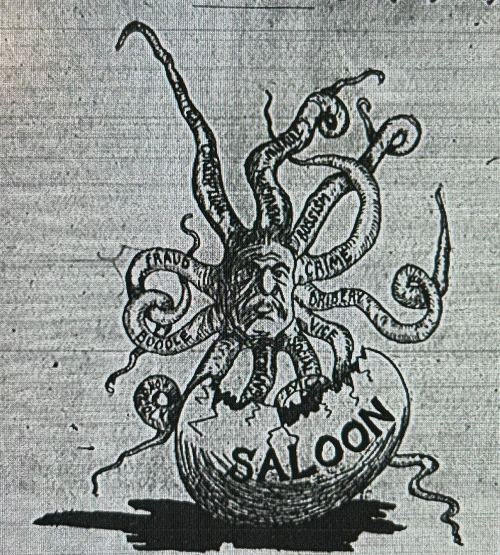
The Austin Informer billed itself as “The Only Negro Journal in Central Texas.” An edition from August 24, 1940 has the following disturbing headline: “Vulture-Picked Body Found Near Tuskegee,” referring to the lynching of Jesse Thornton, a 26 year old man (the Informer has him listed as ‘about 27 years old’) in Luverne, Alabama, murdered after he addressed a white police officer by his given name: “The death of Thornton, who was lynched by a police-led mob because he had ‘forgotten’ to refer to a white plaice officer as ‘m.’ marked the fifth authenticated lynching this year investigated by the Association” (referring to the NAACP).
The newspaper itself did not just report on violence, but was almost a subject: “Two Dapper Youths Threaten Austin Informer Manger,” reads one headline. “Elgin Hychew, youthful and energetic Informer managing editor, narrowly escaped a corking-good beating when he was threatened by two dapper youths here Friday night at the office of the Informer,” following the publication of a story on the previous week’s front page.
The “dapper youths,” Bivina Lee and Finanda Merriweather, were apparently upset at being identified in print at a “bottle blitzkrieg’” at Hill’s Tavern, with Merriweather “playing the principal role in a beer-bottle throwing.” Two people were wounded at the “blitzkrieg,” and neither Merriweather nor Lee came off as more innocent by attempting to beat a member of the press. Another upsetting story from the Informer: “13 yr. old girl is mother.” “The young mother is unconcerned about the whole thing, the physician said, and has a doll one [sic] one side of her bed and the baby on the other.”
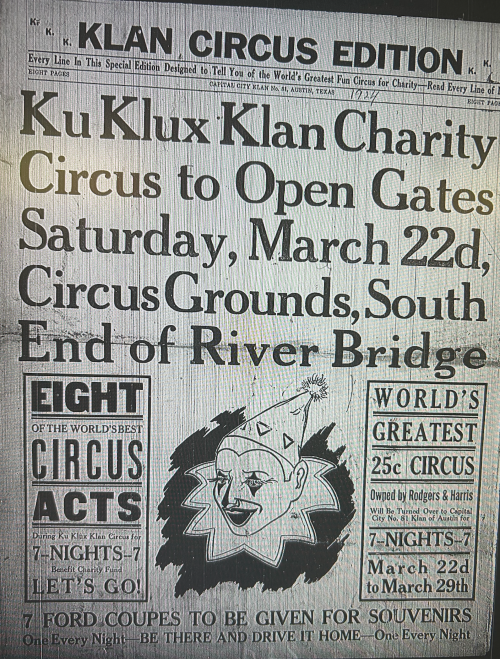
One publication where race was curiously missing was the “Klan Circus Edition,” published in the Capital City Klan in 1924: “Ku Klux Klan Charity Circus to Open Gates Saturday, March 22d, Circus Grounds South End of River Bridge.” A Ford Coupe was advertised as being raffled off every of the seven nights of the circus, and “the music furnished will be by our own Cowboy Band and no doubt a real treat is in store for every one.”
Here is the central pitch: “Never has Austin been fortunate enough to have within its gates a circus such as that which is being operated by the Klan of this city containing such a variety of high class entertainment and staple merchandise to be offered to the public from March 22 to 29. The performers are all high class acts furnished by Rodgers and Harris Circus and nowhere in the world can the public get more for 25c.” Curiously, the only barbed words this publication had were for, I guess, actual carnies: “Positively professional or concession man will be seen connected with this entire show, only in an advisory capacity.” Three years previous to this circus announcement, thousands of members of the Klan marched the streets of Dallas.
The Dirt Farmer-Stockman was more straightforward about prejudice than the notice of the Klan circus. In an editorial written in March 1944 under the title “The South’s Remedy,” the writer states that, “The purpose to maintain white supremacy has been the chief cause preserving political solidarity in the Southern States…this is a white man’s country and will remain such-not to oppress but to protect the negro in his legal rights.”
Newspaper writing in the 40s ducked between the flowery and the straightforward. The Texas Herald, on March 7, 1946, announces the firing of the columnist Paul Mallon with the blunt title “NO MORE MALLON.” “We are discontinuing Paul Mallon’s column, as it did not give the behind-the-scenes news we expected,” they bluntly report. The main story reads “U.T. Refuses to Admit Negro,” the beginning of the famous court case that pitted Herman Marion Sweatt, whose home address is printed here, (“Wants Education”) against UT President Painter (“Whites Only”) which was then punted to Attorney General Grover Sellers (“Hot Potato”) with other considerations (“Pride Costly”) including the most important (“Equal Rights”) taken into account.
I’d like to highlight just two more publications: Freshie, “The Freshman’s Champion,” and Gossip! The edition I found of Freshie was published in September of 1924, and includes poems like, “Hi, There, Freshie,” ending with the stanza “Hi, there, freshie, old and new, Welcome to old Texas U!” Gossip sounds promising, but under the “Chatter Box” subhead are items like, “Gossip’s Dream-at last comes true! Austin now has a municipal flag-How do you like its looks? (all caps).” The page below made me wonder how “gossip” itself was defined:
DVDs
Setting up in a little alcove with two televisions and DVD players, none of recent vintage, I watched parts of “Austin Past and Present” helmed by Karen Kocher. In this series of short historical pieces, we learn or relearn that the selection of Austin as the state capital was controversial, with one legislator declaring Austin was “impassable, not even jackassable.” Sam Houston called Austin “that damned hole.” The series is interesting, though it sometimes dips into the dated (a Ken Burns-y “a-ooga!” horn suggests a busy street; bed springs squeak during a mention of Austin’s former red light district, “Guy Town.”)
Speaking of which, while I was doing research I ran into Bill Baird, a former Austinite and current musician and writer. Now based in his (our) hometown of San Antonio, we got to talking a little about red light districts (like you do), and he mentioned that, in news to me, San Antonio also had its own notorious “Sporting District” which sprouted at the end of the nineteenth century. “[T]he first house of prostitution to appear in what was later designated as the red-light district was noted in 1888, and in twenty years, grew to well over one hundred brothels,” writes Jennifer Cane. The Sporting District did not shutter until 1941.
Bill and I also got to talking about San Antonio music, and he mentioned his writing about the Butthole Surfers, who got their start at Trinity University. I think I referenced the San Antonio band Buttercup, and later curious, I went to the San Antonio Current’s website to see if my piece about them from twenty years ago was still online. It is, but without my byline. Archival accuracy isn’t apparently the Current’s priority, but at least I’m still served up the ugliest ads ever from The Penny Hoarder. Bill is working on his own writing, which includes a book that, I hope I’m not giving too much away here, concerns an important milestone in San Antonio history.
Vinyl and CDs
Many of the CDs and cassettes are in the process of being moved to the AHC’s second location, but I did want to highlight a few interesting items available just through browsing the catalog:
Whoom-Elements: Of Love/Men in the Politics
Unfortunately I wasn’t able to lay hands on this 45, but both tracks are available online. Pulsing, rhythmic heavy post-punk presaging riot grrl by about a decade.
Larry Shannon Hargrove: I Need a Bailout
Homegrown, outsider-artist music brimming with canned drums and synths, Hargrove’s music includes topical political commentary (1998’s “Leave Bill Clinton Alone,” 2009’s recession-era “I Need a Bailout”) but it’s the track “Austin, Texas is my Home” that is most relevant to my project. The AHC has this album on both cassette and CD.
Various Media - Why Do They Have This
I understand that deciding what a library or historical center purchases and makes available is the result of many processes and factors. That said, and speaking only from an amateur capacity, I am at a loss for why the following items are in circulation, let alone in a “library use only” format.
Texersize on LP
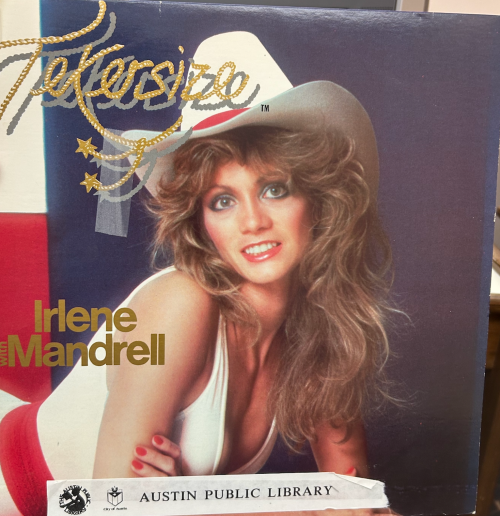
I didn’t know what to expect from the 1983 release “Texersize,” but what did I get but one of the Mandrell sisters (Irlene) spouting exercise commands over an unlistenable simulacrum of country music. This record is not even rare, though it probably should be. I regret my time spent with “Texersize.”
The Best of Austin on DVD
“A collection of multimedia presentations featuring numerous businesses in Austin, Texas. Includes links to merchant web sites and an online game.” Brought to me in a chunky DVD case, this 2002 collection is literally a bunch of (dull) commercials from Austin-area businesses, and the ‘online game’ is just to see if you can recognize a still from one of the ads.
Taking Pride in Austin on LP
Like the above, this 1989 project is not a labor of civic pride but of commerce — and not even of the local variety. As explored in Towers, the “Taking Pride in…” series was the brainchild of “Impact Broadcast Marketing” based in Tennessee, “a now-defunct Nashville recording studio that cranked out ‘Taking Pride In…’ albums for such glamorous locales as Cedar Rapids, Wichita, and “The Inland Northwest” with unsettlingly mechanical precision throughout the late ’80s and early ’90s.”
Conclusion
The AHC sent an email about their move on Valentine’s Day, highlighting collections including the Henry Hirschfeld Haggadah from 1885, an exhibition called “Blackland Prairies: Locating Black Histories in Texas,” and photographs from the Villager newspaper. What the AHC does, forthrightly and quietly, is to recognize who we are as a city and to spotlight the component parts that created Austin (and, if the spirit moves you, to “Texercise”).
Even while clicking through pictures of plants or reading about and then ruminating on what is a ‘hobble skirt,’ I was reminded how important the deliberate act of capturing history is. The AHC collects Austin history, contextualizes it, and invites you in to explore — dedicated to our city at its most enviable and ugly. Ironically, enterprises who try their hardest to suppress their public histories but are observed by historians both professional and amateur doing so — governments, our state’s infamous former energy company, Lance Armstrong lying about being “canceled” — invent their own infamy.
Assaulting history risks self-mutilation. The current administration, as they try and wretch the “T” from LGBT and disappear DEI, fuse their suppression to the history of what they are trying to destroy. When and if we come out of this period of history, god willing, and the desired erasure of trans people and minorities fails, we will have the evidence of what happened. The more ugly it gets, the more we need to make sure we have the tools to help us remember.

